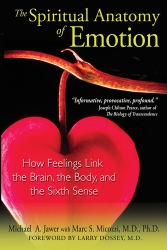"Haunted People" Potentially Explained: New Book Proposes a Mind-Body Basis for Anomalous Perceptions

Rochester, VT, October 22, 2009 --(PR.com)-- People seeing ghosts? There may be a genuine mind-body foundation for such anomalous perceptions, according to two researchers, Michael Jawer and Marc Micozzi, MD, PhD. Their book, The Spiritual Anatomy of Emotion, suggests that sensing a presence, seeing an apparition, or feeling energy around a person or place may be related to the workings of the limbic system – the “emotional brain” – as well as a personality type that rapidly registers feelings.
As surveys consistently show that anywhere from one-third to two-thirds of the public say they’ve had an extra-sensory experience – with nearly 25% of respondents stating they’ve actually seen or felt a ghost – anomalous perceptions are nothing to shrug off. “People have had these experiences down the ages and across all cultures,” comments Micozzi, a physician and anthropologist. “They’re quite universal. What we’ve begun to document is that there’s a certain type of person most likely to experience them.”
That person is environmentally sensitive, according to Jawer, an expert on the condition known as Sick Building Syndrome. “Our data show that anomalous perceptions parallel other forms of environmental sensitivity, such as having pronounced or longstanding allergies, migraine headache, chronic fatigue, chronic pain, irritable bowel, even synesthesia (overlapping senses) and heightened sensitivity to light, sound, touch, and smell. Women make up three-quarters of this sensitive population but there are other markers as well: being ambidextrous, for instance, or recalling a traumatic childhood. The more we look at the people who say they’re psychic, or who have recurring anomalous experience, the more it seems there’s a mix of nature and nurture that predisposes them.”
The researchers posit that brain and body are effectively unified – a perspective taken by the pioneering field of psychoneuroimmunology – and that highly sensitive people react more strongly than others to what they’re feeling as well as to incoming environmental stimuli. This raises the possibility, Jawer and Micozzi assert, that subliminal feelings and other environmental nuances could be picked up by individuals who are sufficiently sensitive. A reputedly “haunted” place, therefore, could exhibit stimuli that register more with certain people and less with others.
“The whole field is ripe for study,” remarks Micozzi. “We have the technology these days to study emotion as it’s processed in the brain – why not widen the scope to study how feelings are felt, and perceptions registered, in the rest of the body. If we look at human beings more holistically, we’re bound to discover more interesting things about us and our interactions with the environment.”
Jawer agrees. “What’s been termed ‘paranormal’ needn’t be beyond the pale of science. What’s been considered ‘occult,’ or hidden, needn’t be. What is needed is to take seriously what highly sensitive people are telling us, and investigate the mind-body basis of what they’re feeling.”
More information is available at the book's website, www.emotiongateway.com.
###
As surveys consistently show that anywhere from one-third to two-thirds of the public say they’ve had an extra-sensory experience – with nearly 25% of respondents stating they’ve actually seen or felt a ghost – anomalous perceptions are nothing to shrug off. “People have had these experiences down the ages and across all cultures,” comments Micozzi, a physician and anthropologist. “They’re quite universal. What we’ve begun to document is that there’s a certain type of person most likely to experience them.”
That person is environmentally sensitive, according to Jawer, an expert on the condition known as Sick Building Syndrome. “Our data show that anomalous perceptions parallel other forms of environmental sensitivity, such as having pronounced or longstanding allergies, migraine headache, chronic fatigue, chronic pain, irritable bowel, even synesthesia (overlapping senses) and heightened sensitivity to light, sound, touch, and smell. Women make up three-quarters of this sensitive population but there are other markers as well: being ambidextrous, for instance, or recalling a traumatic childhood. The more we look at the people who say they’re psychic, or who have recurring anomalous experience, the more it seems there’s a mix of nature and nurture that predisposes them.”
The researchers posit that brain and body are effectively unified – a perspective taken by the pioneering field of psychoneuroimmunology – and that highly sensitive people react more strongly than others to what they’re feeling as well as to incoming environmental stimuli. This raises the possibility, Jawer and Micozzi assert, that subliminal feelings and other environmental nuances could be picked up by individuals who are sufficiently sensitive. A reputedly “haunted” place, therefore, could exhibit stimuli that register more with certain people and less with others.
“The whole field is ripe for study,” remarks Micozzi. “We have the technology these days to study emotion as it’s processed in the brain – why not widen the scope to study how feelings are felt, and perceptions registered, in the rest of the body. If we look at human beings more holistically, we’re bound to discover more interesting things about us and our interactions with the environment.”
Jawer agrees. “What’s been termed ‘paranormal’ needn’t be beyond the pale of science. What’s been considered ‘occult,’ or hidden, needn’t be. What is needed is to take seriously what highly sensitive people are telling us, and investigate the mind-body basis of what they’re feeling.”
More information is available at the book's website, www.emotiongateway.com.
###
Contact
Inner Traditions/Park Street Press
Cynthia Fowles
802-767-3174, x 115
www.emotiongateway.com
Cynthia Fowles
802-767-3174, x 115
www.emotiongateway.com
Categories
